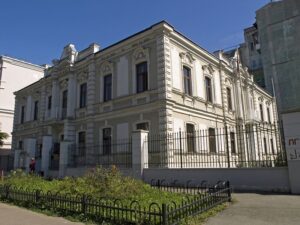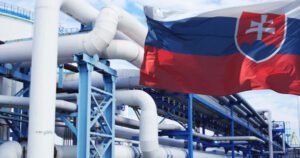
Prime Minister Denys Shmyhal says the European Commission has proposed suspending all import duties on all Ukrainian exports to the European Union for a year.
“Today, the European Commission proposed to suspend for a year all import duties on all Ukrainian exports to the European Union. This is an unprecedented gesture of support for our country. The EU has never taken such massive trade liberalization measures in any country before. This opens up additional opportunities for our business, and our products become more competitive in the European market. We negotiated the abolition of duties with our European colleagues, and we are grateful that they heard us and supported Ukraine,” Shmyhal wrote on the Telegram channel.
Shmygal also said that the government has agreements and is negotiating with Poland, Romania, Lithuania, Germany and other countries to allow Ukrainian exports through the ports of these countries.
“We are working further so that, in addition to the EU countries and the UK, our other allies will also take the decision to abolish duties on Ukrainian products,” he wrote.
EUROPE, EUROPEAN COMMISSION, IMPORT DUTIES, UKRAINIAN EXPORT

President of Ukraine Volodymyr Zelensky received an invitation to participate in the G-20 summit.
“Thank you for the invitation to the G-20 summit,” he tweeted after a phone call with Indonesian President Joko Widodo on Wednesday.
“I thanked for the support of the sovereignty and territorial integrity of Ukraine, in particular, for a clear position in the UN. Food security issues were discussed,” he also wrote.
The G-20 summit will take place in autumn 2022 in Indonesia.

Employees of the Austrian embassy in Ukraine returned to Kyiv last week, the Austrian Ministry of Foreign Affairs reported.
“We are united with the people of Ukraine, who have become victims of unprecedented military aggression by Russia. As an important sign of our unwavering solidarity with Ukraine, our embassy staff returned to Kyiv last week. Thank you to our staff for your efforts and dedication!” the Foreign Ministry tweeted on Wednesday.

Prime Minister Denys Shmyhal has discussed with Romanian Prime Minister Nicolae Ciucă the possibility of expanding export and transit corridors through Romania, as well as using additional facilities of Romanian seaports.
“We discussed the possibility of expanding the already established export corridors, transit corridors through the territory of Romania, as well as using the additional capabilities of Romanian seaports and checkpoints between our countries,” Shmyhal said at a joint briefing with Ciucă on Tuesday evening.
The parties also discussed the process of restoring the settlements of Ukraine affected by the war, and also discussed the participation of Romania in such projects.
In addition, the prime ministers discussed cooperation between countries in the energy sector, economy, business and transit potential.
Among other things, he thanked Romania for launching and operating hubs on its territory for international technical and humanitarian support to Ukraine, as well as for helping displaced Ukrainian citizens.
In addition, Shmyhal said that the countries are working on a draft memorandum of cooperation to ensure the social protection of children who have suffered in war and armed conflicts.
Later, the press service of the government reported that at a meeting of the parties Shmyhal proposed to consider the possibility of opening the Diakivtsi (Ukraine) – Racovăț (Romania) checkpoint as soon as possible and further granting it the status of a checkpoint for cargo transportation to increase transit opportunities between Ukraine and Romania.
In addition, he noted the role of Romania in the international processes of condemnation and punishment of Russia for crimes against humanity and acts of genocide that continue on the territory of Ukraine.
In turn, the Prime Minister of Romania assured that they will continue to support Ukraine in its fight and will support the tightening of sanctions against the aggressor.

A group of people’s deputies propose to the Parliament to refuse exemption from import duties, excise tax and VAT on car imports, bill No. 7311, the text of which is posted on the website of the Verkhovna Rada, testifies. the budget received less than 350 million hryvnia, and now the daily amount of benefits is 100 million hryvnia.
At the same time, not isolated cases of the importation of premium cars were recorded, the authors of the bill note, among them is the head of the Verkhovna Rada Committee on Finance, Tax and Customs Policy Daniil Getmantsev.
The bill also proposes to return taxation for goods imported by single tax payers of the first or third group.
The authors of the bill point out that during the week of such relaxations, the budget received less than UAH 417 million.
As reported, on March 24, 2022, the Verkhovna Rada of Ukraine, in order to stimulate important imports for the country, among a number of goods for the period of martial law, exempted the import of vehicles by citizens from taxation (cars, motorcycles, trucks and buses).
According to the State Customs Service, over the month, Ukrainians have issued more than 19,000 cars on preferential terms, which created problems and delays for the import of humanitarian aid.

Slovakia will continue to pay for Russian gas in euros in accordance with the agreed rules, Slovak Prime Minister Edward Heger said.
“The company Slovensky plynarensky priemysel (Slovak gas industry) has signed a long-term contract with the Russian Gazprom and payments for the purchased gas will be made in euros in accordance with the agreed rules and recommendations of the European Commission,” Heger wrote on the social network.
Slovensky plynarensky priemysel is the largest oil refinery in the country.
The Prime Minister also announced on Twitter (SPB: TWTR) that Slovakia, together with the EU, will accelerate the move away from gas dependence on Russia.